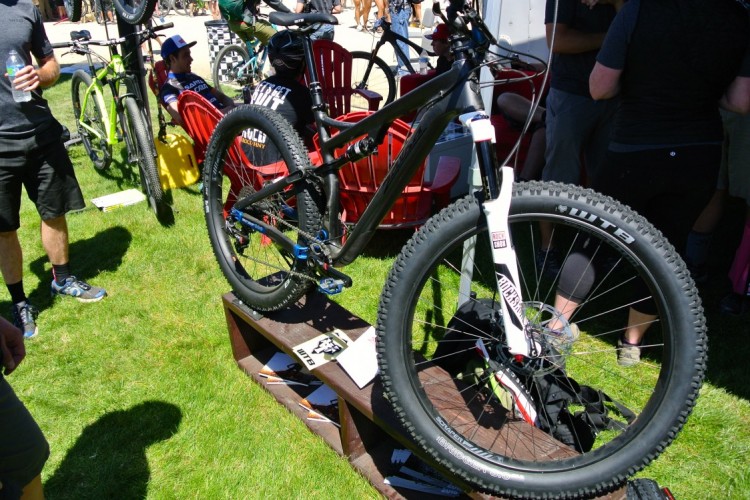
Over the past 18 months we’ve seen an explosion of plus bikes hitting the market, so we wondered: “Who is buying these bikes and what are the most popular configurations?” As usual, we uncovered some interesting and surprising insights!
Right off the bat we were shocked to find that a lot riders don’t know what “plus” really means when it comes to mountain bikes. Fully 22% of respondents said they owned a plus bike but in reality we determined (based on responses to follow up questions) they did not. We think part of the confusion stems from the timing of the introduction of 27.5+ just as standard 27.5 wheels were becoming mainstream. So for those who may still be confused, 27.5 is not the same as 27.5+.
At the time of our survey (conducted in February), plus bike ownership was split almost evenly between 27.5+ and 29+ bikes, with 29+ having a slight edge. This might seem surprising given the huge number of 27.5+ bikes on the market compared to 29+ bikes but remember, 29+ started out a couple years ahead of 27.5+. This will be interesting to track over time but all indications point toward future 27.5+ adoption far outstripping 29+ and perhaps, 29+ falling off the radar entirely.
Unlike fat bikes, plus bikes aren’t typically marketed as being particularly well suited for riding in snow. Consequently, we’re seeing early adoption happening much more broadly across all regions of the world. Contrast that with fat bikes, which have seen higher adoption rates in places like the Central and Eastern US and Canada where snow is a factor, and lower rates where it is not.
It’s also interesting to note that plus bikes have been adopted by older riders at increasing rates. Starting with under 18-year-old riders, each increasing age group shows higher adoption rates than the age group below it, with the exception of the 55+ group. At this point with overall plus bike adoption rates hovering around 4%, it stands to reason that older riders are the ones with more disposable income and are therefore more likely to be early adopters. Knowing that plus bikes make technical terrain easier to navigate and that they’re also slightly heavier than equivalent bikes with skinnier wheels and tires might also hint at some correlation with age-group adoption rates.
As with any new technology or standard in the bike industry, riders are split on whether plus bikes are a good thing or a bad thing. Generally the tone of survey responses seemed to lean toward the positive.
In looking at the types of plus bikes riders own, it’s interesting to note the differences between the 27.5+ and 29+ bikes being purchased. There still isn’t a single mainstream full suspension 29+ bike on the market, which limits who these bikes appeal to. Based on the survey data, we’re seeing mostly steel, all hardtail, and limited travel 29+ bikes being used for bikepacking and off road touring. In contrast, the 27.5+ bikes riders own are carbon and aluminum, full suspension, and around 120mm of travel. The variety of 27.5+ designs certainly seems to be a strength over 29+ in terms of potential future adoption.
The brands currently dominating 29+ and 27.5+ sales are also very different. In the 29+ market, niche brands with cult followings like Surly and Niner are doing well, while the 27.5+ market is already being dominated by larger players like Specialized and Norco.
In the plus size tire market, we found a surprising diversity in the brands mentioned. Many of these tires started life as fat bike tires and have been sized down to work for plus bikes. The upshot is there are plenty of tires to choose from today, up from just a couple choices only 18 months ago.
Your Turn: What stands out to you about the plus bike data? Let us know if you’re planning to go plus size in the future and which bike you plan to buy!





















11 Comments
Apr 25, 2016
Apr 25, 2018
Apr 26, 2016
It could be done, there are full-suspension fat bikes after all, but there's not enough of a market for major manufacturers to invest in 29+ full squish. Lenz Sport - makers of all sorts of weird ass bikes - has a couple 29+ bikes in their line: http://lenzsport.com/mountain-bikes/
May 7, 2018
Apr 25, 2018
Apr 25, 2018
Apr 26, 2016
Apr 29, 2016
My friend was demoing the new Mojo 3 with 2.35 tires and we traded a few times. His description was best. The Hightower was like an old Cadillac you instantly felt comfortable. If I was an instructor I would use this bike for first timers. It's very forgiving and smoothes out the trail.
Apr 25, 2018
Apr 25, 2016
Apr 29, 2016
I live in Boise, Idaho where we have excellent training grounds: Ridge to Rivers Program with over 190 miles of maintained trails and growing, plus Eagle Bike Park. I selected the Scott Genius Plus for their 27.5 x 2.8 tubeless tires using 40 mm rim width and their Twinloc suspension system. Performs as I hoped: minor speed lost, excellent climber, great traction in sandy terrain, smooth control in steep rocky terrain, and a lot of fun. Currently running 13.5 PSI in rear tire and 12 PSI in front tire. Only swap out was to Wolf Tooth 28t front chainring for our steep trails. No regrets.